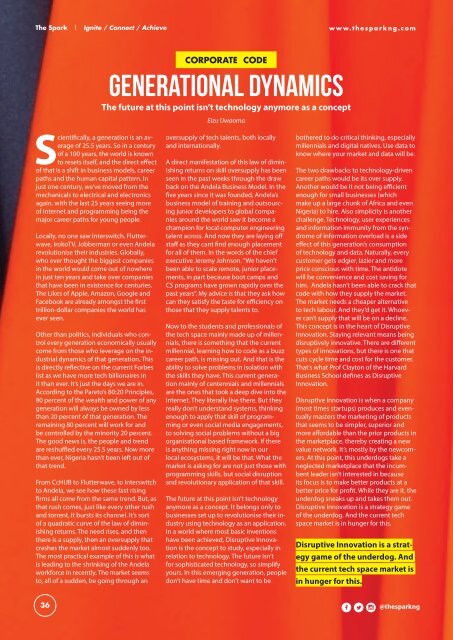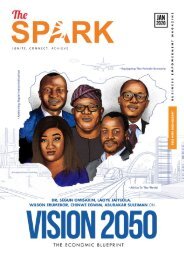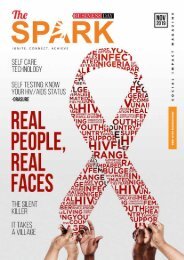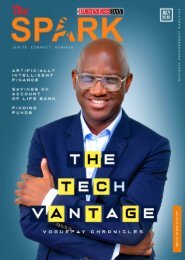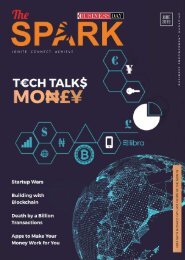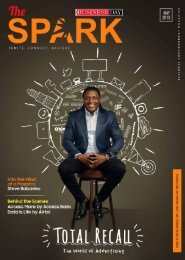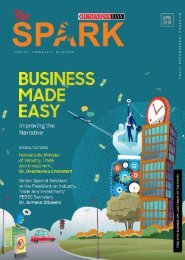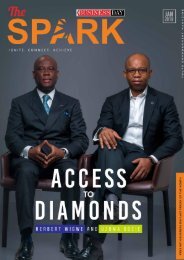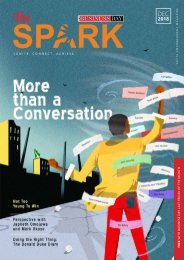Made in Nigeria
September - Made in Nigeria Edition
September - Made in Nigeria Edition
Create successful ePaper yourself
Turn your PDF publications into a flip-book with our unique Google optimized e-Paper software.
The Spark | Ignite / Connect / Achieve<br />
www.thesparkng.com<br />
CORPORATE CODE<br />
Generational Dynamics<br />
The future at this po<strong>in</strong>t isn’t technology anymore as a concept<br />
Eizu Uwaoma<br />
Scientifically, a generation is an average<br />
of 25.5 years. So <strong>in</strong> a century<br />
of a 100 years, the world is known<br />
to resets itself, and the direct effect<br />
of that is a shift <strong>in</strong> bus<strong>in</strong>ess models, career<br />
paths and the human capital pattern. In<br />
just one century, we’ve moved from the<br />
mechanicals to electrical and electronics<br />
aga<strong>in</strong>, with the last 25 years see<strong>in</strong>g more<br />
of <strong>in</strong>ternet and programm<strong>in</strong>g be<strong>in</strong>g the<br />
major career paths for young people.<br />
Locally, no one saw Interswitch, Flutterwave,<br />
IrokoTV, Jobberman or even Andela<br />
revolutionise their <strong>in</strong>dustries. Globally,<br />
who ever thought the biggest companies<br />
<strong>in</strong> the world would come out of nowhere<br />
<strong>in</strong> just ten years and take over companies<br />
that have been <strong>in</strong> existence for centuries.<br />
The Likes of Apple, Amazon, Google and<br />
Facebook are already amongst the first<br />
trillion-dollar companies the world has<br />
ever seen.<br />
Other than politics, <strong>in</strong>dividuals who control<br />
every generation economically usually<br />
come from those who leverage on the <strong>in</strong>dustrial<br />
dynamics of that generation. This<br />
is directly reflective on the current Forbes<br />
list as we have more tech billionaires <strong>in</strong><br />
it than ever. It’s just the days we are <strong>in</strong>.<br />
Accord<strong>in</strong>g to the Pareto’s 80:20 Pr<strong>in</strong>ciples,<br />
80 percent of the wealth and power of any<br />
generation will always be owned by less<br />
than 20 percent of that generation. The<br />
rema<strong>in</strong><strong>in</strong>g 80 percent will work for and<br />
be controlled by the m<strong>in</strong>ority 20 percent.<br />
The good news is, the people and trend<br />
are reshuffled every 25.5 years. Now more<br />
than ever, <strong>Nigeria</strong> hasn’t been left out of<br />
that trend.<br />
From CcHUB to Flutterwave, to Interswitch<br />
to Andela, we see how these fast ris<strong>in</strong>g<br />
firms all come from the same trend. But, as<br />
that rush comes, just like every other rush<br />
and torrent, it bursts its channel. It’s sort<br />
of a quadratic curve of the law of dim<strong>in</strong>ish<strong>in</strong>g<br />
returns. The need rises, and then<br />
there is a supply, then an oversupply that<br />
crashes the market almost suddenly too.<br />
The most practical example of this is what<br />
is lead<strong>in</strong>g to the shr<strong>in</strong>k<strong>in</strong>g of the Andela<br />
workforce <strong>in</strong> recently. The market seems<br />
to, all of a sudden, be go<strong>in</strong>g through an<br />
oversupply of tech talents, both locally<br />
and <strong>in</strong>ternationally.<br />
A direct manifestation of this law of dim<strong>in</strong>ish<strong>in</strong>g<br />
returns on skill oversupply has been<br />
seen <strong>in</strong> the past weeks through the draw<br />
back on the Andela Bus<strong>in</strong>ess Model. In the<br />
five years s<strong>in</strong>ce it was founded, Andela’s<br />
bus<strong>in</strong>ess model of tra<strong>in</strong><strong>in</strong>g and outsourc<strong>in</strong>g<br />
junior developers to global companies<br />
around the world saw it become a<br />
champion for local computer eng<strong>in</strong>eer<strong>in</strong>g<br />
talent across. And now they are lay<strong>in</strong>g off<br />
staff as they cant f<strong>in</strong>d enough placement<br />
for all of them. In the words of the chief<br />
executive Jeremy Johnson. “We haven’t<br />
been able to scale remote, junior placements,<br />
<strong>in</strong> part because boot camps and<br />
CS programs have grown rapidly over the<br />
past years”. My advice is that they ask how<br />
can they satisfy the taste for efficiency on<br />
those that they supply talents to.<br />
Now to the students and professionals of<br />
the tech space ma<strong>in</strong>ly made up of millennials,<br />
there is someth<strong>in</strong>g that the current<br />
millennial, learn<strong>in</strong>g how to code as a buzz<br />
career path, is miss<strong>in</strong>g out. And that is the<br />
ability to solve problems <strong>in</strong> isolation with<br />
the skills they have. This current generation<br />
ma<strong>in</strong>ly of centennials and millennials<br />
are the ones that took a deep dive <strong>in</strong>to the<br />
Internet. They literally live there. But they<br />
really don’t understand systems, th<strong>in</strong>k<strong>in</strong>g<br />
enough to apply that skill of programm<strong>in</strong>g<br />
or even social media engagements,<br />
to solv<strong>in</strong>g social problems without a big<br />
organisational based framework. If there<br />
is anyth<strong>in</strong>g miss<strong>in</strong>g right now <strong>in</strong> our<br />
local ecosystems, it will be that. What the<br />
market is ask<strong>in</strong>g for are not just those with<br />
programm<strong>in</strong>g skills, but social disruption<br />
and revolutionary application of that skill.<br />
The future at this po<strong>in</strong>t isn’t technology<br />
anymore as a concept. It belongs only to<br />
bus<strong>in</strong>esses set up to revolutionise their <strong>in</strong>dustry<br />
us<strong>in</strong>g technology as an application.<br />
In a world where most basic <strong>in</strong>ventions<br />
have been achieved, Disruptive Innovation<br />
is the concept to study, especially <strong>in</strong><br />
relation to technology. The future isn’t<br />
for sophisticated technology, so simplify<br />
yours. In this emerg<strong>in</strong>g generation, people<br />
don’t have time and don’t want to be<br />
bothered to do critical th<strong>in</strong>k<strong>in</strong>g, especially<br />
millennials and digital natives. Use data to<br />
know where your market and data will be.<br />
The two drawbacks to technology-driven<br />
career paths would be its over supply.<br />
Another would be it not be<strong>in</strong>g efficient<br />
enough for small bus<strong>in</strong>esses (which<br />
make up a large chunk of Africa and even<br />
<strong>Nigeria</strong>) to hire. Also simplicity is another<br />
challenge. Technology, user experiences<br />
and <strong>in</strong>formation immunity from the syndrome<br />
of <strong>in</strong>formation overload is a side<br />
effect of this generation’s consumption<br />
of technology and data. Naturally, every<br />
customer gets edgier, lazier and more<br />
price conscious with time. The antidote<br />
will be convenience and cost sav<strong>in</strong>g for<br />
him. Andela hasn’t been able to crack that<br />
code with how they supply the market.<br />
The market needs a cheaper alternative<br />
to tech labour. And they’d get it. Whoever<br />
can’t supply that will be on a decl<strong>in</strong>e.<br />
This concept is <strong>in</strong> the heart of Disruptive<br />
Innovation. Stay<strong>in</strong>g relevant means be<strong>in</strong>g<br />
disruptively <strong>in</strong>novative. There are different<br />
types of <strong>in</strong>novations, but there is one that<br />
cuts cycle time and cost for the customer.<br />
That’s what Prof Clayton of the Harvard<br />
Bus<strong>in</strong>ess School def<strong>in</strong>es as Disruptive<br />
Innovation.<br />
Disruptive Innovation is when a company<br />
(most times startups) produces and eventually<br />
masters the market<strong>in</strong>g of products<br />
that seems to be simpler, superior and<br />
more affordable than the prior products <strong>in</strong><br />
the marketplace, thereby creat<strong>in</strong>g a new<br />
value network. It’s mostly by the newcomers.<br />
At this po<strong>in</strong>t, this underdogs take a<br />
neglected marketplace that the <strong>in</strong>cumbent<br />
leader isn’t <strong>in</strong>terested <strong>in</strong> because<br />
its focus is to make better products at a<br />
better price for profit. While they are it, the<br />
underdog sneaks up and takes them out.<br />
Disruptive Innovation is a strategy game<br />
of the underdog. And the current tech<br />
space market is <strong>in</strong> hunger for this.<br />
Disruptive Innovation is a strategy<br />
game of the underdog. And<br />
the current tech space market is<br />
<strong>in</strong> hunger for this.<br />
36<br />
fli @thesparkng


